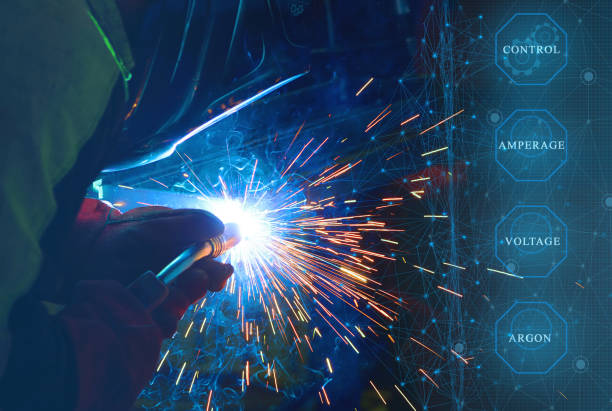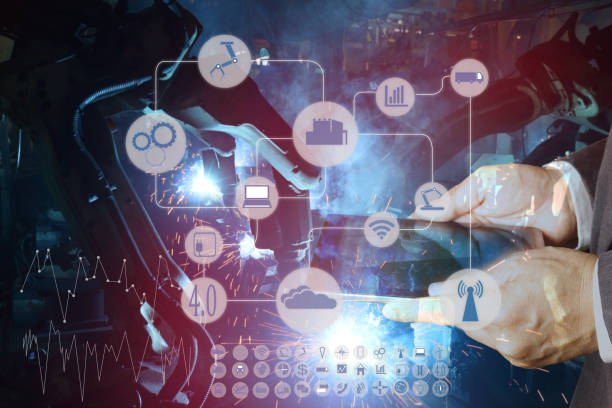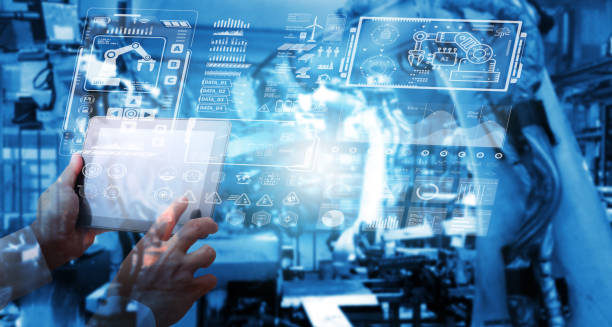Welding is one of the backbone processes in manufacturing and infrastructure — but it’s also complex, demanding, and prone to quality issues. Thanks to recent advances in artificial intelligence (AI) and machine learning (ML), welders and fabricators now have powerful tools to improve consistency, reduce waste, and boost safety. In this article, we'll explore how AI and ML are transforming welding automation systems, highlight real-world applications, and explain what this means for both human welders and smart factories.

I. What’s Driving the AI Wave in Welding?
AI and ML are reshaping welding for several key reasons:
Precision and Consistency: AI can analyze real-time sensor data and automatically fine-tune welding parameters — ensuring more consistent quality and fewer defects than purely manual welding.
Predictive Maintenance: By collecting data from welding equipment, AI can forecast when a machine may fail. This helps prevent costly downtime and unplanned repairs.
Safety Improvements: Automating dangerous or repetitive welding tasks reduces human exposure to risks. AI-driven robots or systems can work in challenging and hazardous environments, keeping humans out of harm’s way.
Faster Training: Machine learning helps speed up the training of new welders, transferring expert-level weld skills into simulators and real systems.
II. Core Applications of AI in Welding
Here are some of the most important ways AI and ML are being applied in welding today:

1. Real-Time Monitoring and Adaptive Control
AI systems use sensors (e.g., cameras, current sensors) to monitor the weld in real time and make minute adjustments during welding. For example, if the arc becomes unstable or heat input fluctuates, the AI controller adjusts the parameters to compensate.
This helps maintain weld quality and reduce defects such as porosity or undercut, as described in real-world industrial systems.
2. Quality Assurance and Defect Detection
Machine vision — powered by ML — can detect weld imperfections like cracks, misalignment, or lack of fusion as they form or immediately afterward.
By analyzing historical weld data, AI can learn patterns that lead to defects and raise alerts or trigger corrective actions before a weld fails.
3. Predictive Maintenance
AI-driven predictive maintenance uses sensor data (e.g., temperature, vibration, usage metrics) to predict when welding equipment might need servicing.
This allows maintenance to be scheduled proactively, avoiding unexpected breakdowns.
4. Path Planning and Optimization
AI systems can analyze design data (e.g., CAD drawings) to automatically plan the most efficient weld paths, reducing setup time and minimizing wasted motion.
When used with robotic welders or cobots, this leads to smarter, more efficient weld operations.
5. Training and Skill Transfer
Machine learning can capture the technique of expert welders (e.g., motion patterns, arc behavior) and encode them into training simulators or automated welding systems.
Researchers have also developed XR (extended reality) welding trainers that use motion and audio feedback together with TinyML models to train welders. This helps new welders learn faster and more effectively.
6. Smart Factory Integration
In smart manufacturing environments, welding systems can be integrated into the IoT (Internet of Things). Sensors collect data, AI analyzes it, and systems adjust processes or issue alerts in real time.
This not only improves quality and efficiency but also enhances safety by monitoring environmental conditions, operator behavior, and equipment health.
III. Real-World Examples & Evidence of AI in Welding Automation
1. AI Adapting in Real Time
A modern welding system can continuously adapt its parameters. For example, AI systems have been demonstrated that adjust weld current, speed, or arc length during welding to avoid defects or overwrite.
2. Learning Welders’ Skills
Machine learning applications have been shown to accelerate the learning curve for welders. By capturing expert welders’ actions, ML models help automate or guide welders-in-training toward optimal technique.
Carnegie Mellon University even built an XR-based welding training system that uses sensors and sound: their classifiers detect welding errors in real time and coach users through a headset.
3. Predicting Failures in Resistance Welding
In resistance welding (widely used in high-volume manufacturing), AI models trained on process data can identify signs of wear or drift in equipment parameters.
This insight helps manufacturers shift from reactive repair to scheduled, intelligent maintenance.
IV. Benefits for Manufacturers and Welders
| Stakeholder | Benefit |
|---|
| Manufacturers / Fabricators | - Higher productivity through fewer defects and rework - Lower operating costs via predictive maintenance - Efficient use of materials with optimized process parameters - Better utilization of labor, including less experienced welders trained via AI systems |
| Welders | - Safer working conditions, reduced exposure to hazardous tasks - Accelerated learning and skill development - Assistance from real-time guidance systems - Opportunity to upskill into more technical roles (robot operator, AI system integrator) |
V. Challenges and Considerations
AI in welding is not without hurdles. Here are some key challenges:
Data Requirements: AI systems must be trained on large, high-quality weld datasets (sensor readings, images, defect logs). Collecting and curating this data can be time-consuming.
Integration Costs: Setting up AI-capable welding systems and sensor networks can require significant upfront investment.
Workforce Adoption: Some welders may resist AI or feel threatened. Adoption requires training and buy-in.
Cybersecurity: As welding systems connect to networks (IoT), protecting them from cyber threats becomes essential.
Model Generalization: AI models trained in one environment (material, process) may not transfer well to another unless carefully adapted.
VI. The Future of Smart Welding
Looking ahead, here are trends likely to shape AI in welding:

1. More Real-Time AI Systems
The next generation of welding systems will rely on even faster feedback loops. AI will adjust welds dynamically, not just batch by batch.
2. Explainable AI / Trustworthy AI
As defect-detection models become more critical, developers will emphasize transparency, interpretability, and human-in-the-loop designs, so welders trust AI decisions.
3. Edge AI & TinyML
Lightweight ML models running on low-power devices (microcontrollers, weld gun sensors) will enable on-board decision-making without cloud dependence.
4. Multimodal Learning
AI systems that combine vision, sound, and sensor data will better understand weld quality. For instance, researchers have already used audio to detect weld start/end and classify weld error types.
5. Digital Twins & Simulation
Welding “digital twins” – virtual replicas of real weld cells – will allow AI to simulate and optimize welding scenarios before actual production, reducing trial-and-error.
6. Workforce Transformation
Welders will increasingly become “welding technologists”: experts in both manual welding and AI-guided or robotic systems. Training programs will evolve accordingly.
VII. Why Megmeet Matters in This Transition
As a forward-looking company in welding automation, Megmeet is well-positioned to ride the AI wave. By integrating intelligent control systems, data capture, and smart feedback loops, Megmeet’s welding solutions can help manufacturers:
Lower scrap and rework costs
Improve first-pass weld quality
Reduce downtime via predictive maintenance
Empower welders with AI-assisted skill development
Such innovation not only improves immediate production metrics, but helps future-proof welding lines against technological shifts.
VIII. FAQs: AI & Machine Learning in Welding
Q1: Will AI eliminate welding jobs?
A: No, not entirely. While AI and automation can take over repetitive or hazardous welding tasks, skilled welders will still be needed — especially for complex, custom, or unusual welds. In many cases, welders may shift into roles overseeing AI systems, programming robots, or maintaining smart welding cells.
Q2: Do I need to be a data scientist to work with AI-driven welders?
A: Not necessarily. While understanding data helps, many AI welding systems are designed with user-friendly interfaces. However, there will be demand for welders who can operate, interpret, and maintain AI-enabled systems.
Q3: Does AI improve all types of welding (MIG, TIG, resistance, etc.)?
A: Yes, AI has applications across many welding types. For example, in resistance welding, AI can analyze current signatures to predict electrode wear. In arc welding (MIG, TIG, etc.), AI can adjust arc parameters, detect defects, and optimize paths.
Q4: Is it safe to rely on AI for weld quality assurance?
A: When properly trained and validated, AI-based vision systems can detect many types of defects with high accuracy. But it’s not a complete replacement for human inspection — rather, a powerful assist. Combining AI with human expertise tends to produce the best outcomes.
Q5: How can a welding shop begin adopting AI?
A: Some recommended steps:
Start with a pilot project: retrofit a welding cell with sensors + data capture
Partner with a vendor that supports AI welding control systems
Collect and label weld data (good vs. defect)
Train or acquire personnel familiar with AI / data systems
Gradually scale once ROI is demonstrated
Conclusion
AI and ML are no longer futuristic buzzwords in welding — they are real tools reshaping how welds are made, inspected, and mastered. By enabling adaptive control, predictive maintenance, real-time quality feedback, and smarter training, AI helps welders produce better welds faster and safer. For manufacturers, this means reduced scrap, more uptime, and higher throughput. For welders, it means evolving into high-skill, technology-enabled craftsmen.
As the industry moves forward, companies like Megmeet that invest in intelligent welding systems will help lead this transformation. The future of welding is not just about sparks — it's about data, learning, and innovation.
Related articles:
1. Robotic Welding & Complete Automation Solutions
2. Megmeet - Pioneering Chinese Welding Machines for Precision and Automation
3. Best TIG Welders: Buyer's Guide For TIG AC/DC Welding Machines in 2023
4. 5 Applications of Laser Welding in Industries (Advantages & Cases)
5. Megmeet Welding | Best Welding Machine, Robotic Welding Equipment Manufacturer in China






